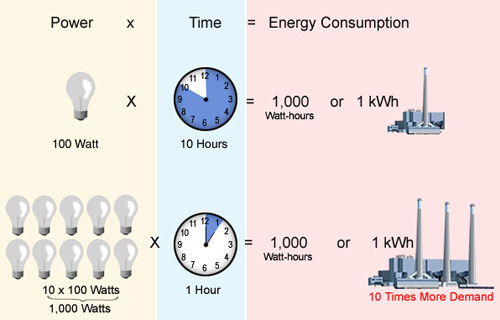Disclosure: This post contains affiliate links and I will be compensated if you make a purchase after clicking through my links. Learn More
Understanding watts and watt hours can be confusing. Yet, they are essential for grasping energy consumption and efficiency.
Watts measure power. Watt hours measure energy over time. Knowing the difference helps you better manage your energy use. This knowledge is crucial for making informed decisions about appliances and energy bills. Grasping these concepts can save you money and reduce your environmental impact.
We will help you to clear up the confusion. You’ll learn what watts and watt hours are. And how they affect your daily life. Dive in to become more energy savvy.
Watts Explained
Watts measure power, indicating the rate of energy use. Watt-hours represent total energy used over time. Understanding these terms helps in managing energy consumption efficiently.
Understanding watts can seem like learning a new language, especially if you’re not an electrician or a physics enthusiast. Yet, this knowledge is crucial whether you’re buying a new appliance, setting up a home office, or simply trying to cut down your energy bills. Grasping what a watt is and how it functions can empower you to make smarter energy choices.
Definition Of Watts
A watt is a unit of power. It measures the rate at which energy is used or produced. You can think of it as the speedometer for electricity, telling you how fast energy is being consumed or generated at any moment.
One watt is equivalent to one joule per second. This might sound technical, but it’s a simple way to understand how energy is flowing. Imagine having a light bulb that uses 60 watts. It’s using 60 joules of energy every second to keep your room lit.
Function Of Watts
Watts help you understand how powerful an electrical device is. The higher the wattage, the more energy it needs to operate.
This can directly impact your electricity bill. If you have multiple high-wattage devices running simultaneously, expect a higher bill at the end of the month.
Think of watts when you’re buying a new gadget. Do you really need a 2000-watt hairdryer, or will a 1200-watt model suffice? Making mindful choices here can save you money and energy.
Watts also come into play when your home’s wiring is considered. If you overload a circuit with too many high-wattage devices, it might trip the breaker. This not only disrupts your activities but could also pose safety risks.
So next time you plug in a device, take a moment to check its wattage. Are you using more energy than necessary? Understanding watts can help you make better decisions and manage your energy consumption wisely.
Watt Hours Explained
Understanding the term ‘Watt Hours’ can seem challenging at first. It’s a crucial concept for anyone dealing with electrical devices or energy consumption. Knowing what watt hours are helps in calculating energy needs and efficiency.
Concept Of Watt Hours
Watt hours measure energy usage over time. One watt hour equals one watt of power used for one hour. It’s a simple way to understand how much energy a device consumes. Imagine a 60-watt light bulb. If it runs for one hour, it uses 60 watt hours.
This measurement helps compare energy use among different devices. For example, a laptop might use 50 watt hours, while a refrigerator uses 300 watt hours. This comparison helps in making efficient energy choices.
Purpose Of Watt Hours
Watt hours help in managing energy consumption effectively. They show how long a device can run on a specific energy source. For example, a battery with 1000 watt hours can power a 100-watt device for 10 hours.
This information aids in planning energy needs. It helps in deciding battery size for gadgets or solar genarator capacity for homes. Understanding watt hours can lead to better energy efficiency and cost savings.
Power Vs Energy
Understanding the difference between power and energy is very important for making informed decisions about your electrical usage. While both terms are often used interchangeably, they represent different concepts. Knowing the distinction can help you better manage your electricity consumption and potentially save money.
Read More: Starting Watts vs Running Watts
Power Measurement
Power is the rate at which energy is consumed or produced. It is measured in watts (W). Imagine you have a 100-watt light bulb. When this bulb is turned on, it uses 100 watts of power continuously.
Think of power as the speed of a car. Just as you measure speed in miles per hour (mph), you measure power in watts. The faster the car, the higher the speed. Similarly, the higher the wattage, the more power is being used at that moment.
Consider the devices in your home. A microwave might use 1000 watts, while a phone charger uses only 5 watts. The microwave consumes a lot more power when it’s running.
Energy Measurement
Energy, on the other hand, is the total amount of power used over time. It is measured in watt-hours (Wh). If you leave that 100-watt light bulb on for one hour, it will consume 100 watt-hours of energy.
Think of energy like the total distance a car travels. If you drive at 60 mph for one hour, you cover 60 miles. Similarly, if an appliance uses 100 watts for one hour, it uses 100 watt-hours of energy.
Practical Applications
Understanding watts and watt-hours can enhance energy efficiency in daily life. These terms are fundamental in evaluating appliance power and energy consumption. With practical applications, one can make informed decisions to manage energy usage better.
Usage In Appliances
Appliances often display wattage ratings. This indicates their power consumption. Higher wattage means more power usage. For instance, a microwave might use 1000 watts. A light bulb might use 60 watts. Watt-hours measure how long an appliance runs. A microwave running for one hour uses 1000 watt-hours. A light bulb running for ten hours uses 600 watt-hours.
Role In Energy Consumption
Watt-hours are crucial in tracking energy consumption. They help calculate electricity bills. Know your appliance’s wattage and usage time. This helps predict energy costs. Energy meters often use watt-hours for readings. Managing watt-hour usage can reduce costs. It also helps conserve energy.
Calculation Methods
Understanding the difference between watts and watt-hours is crucial in energy discussions. Grasping the calculation methods helps in making informed energy choices. Watts measure power. Watt-hours measure energy usage over time. Each has distinct calculation methods. Let’s dive into the details.
Calculating Watts
Watts measure the rate of energy transfer. It’s simple to calculate. Use the formula: Watts = Volts x Amps. Volts represent the electrical potential. Amps denote the current flow. This calculation gives the power used at any moment. Think of it as the speedometer of energy use.
Determining Watt Hours
Watt-hours track energy usage over time. The formula is straightforward: Watt-hours = Watts x Hours. Multiply the power by the time it operates. This gives the total energy consumed. It’s like tracking miles on a car. The longer the device runs, the more energy it uses.

Credit: c03.apogee.net
Common Misconceptions
Many people confuse watts and watt-hours. Watts measure power, while watt-hours measure energy usage over time. Knowing the difference helps in understanding energy consumption.
Understanding the difference between watts and watt-hours can be tricky. Many people mix them up, leading to confusion. This misunderstanding often results in poor decisions about energy usage and efficiency. Let’s clear up these common misconceptions so you can make informed choices about your energy needs.
Confusion Between Terms
People often use “watts” and “watt-hours” interchangeably, but they measure different things. Watts tell you the rate at which energy is used or produced. It’s like knowing how fast your car is going. Watt-hours, on the other hand, measure the total amount of energy used over time. It’s similar to the distance your car travels in an hour.
Imagine you have a 100-watt light bulb. The watts indicate how much power the bulb uses. If you run it for 10 hours, it will consume 1,000 watt-hours. Knowing this helps you understand your electricity bill better.
Clarifying Differences
Watts measure power, while watt-hours measure energy consumption. Think of watts as the speed of energy usage and watt-hours as the total journey. This distinction is crucial when managing home energy use.
Consider your smartphone charger. It may use 5 watts of power, but if you charge your phone for 2 hours, it uses 10 watt-hours of energy. Knowing this can help you decide when to charge your devices to save on electricity.
Have you ever wondered why your electricity bill is high despite using energy-efficient appliances? Misunderstanding watts and watt-hours could be the reason. By grasping these concepts, you can better track and reduce your energy consumption.
Impact On Electricity Bills
Understanding Watts and Watt Hours can help manage electricity bills. These terms often confuse many. Yet, they play a crucial role in energy consumption and cost. Knowing their impact can lead to smarter energy use. This knowledge can save money and reduce waste.
Watts Influence
Watts measure the rate of energy use at a moment. Think of it as the speed of energy consumption. High-watt devices use more energy quickly. For instance, a 100-watt bulb consumes energy faster than a 60-watt bulb. This influences electricity bills by increasing usage rates.
Using high-watt appliances for long periods raises costs. Each extra watt contributes to the total energy bill. Monitoring wattage helps control energy expenses. Choosing appliances with lower wattage can reduce electricity costs.
Watt Hours Impact
Watt Hours measure total energy used over time. They show how long energy is consumed. For example, a 100-watt bulb running for 10 hours uses 1,000 watt hours. This directly affects electricity bills. It translates usage into a billable amount.
Understanding watt hours helps in tracking energy usage. It can identify which devices consume more power over time. This insight allows for better energy management. Reducing unnecessary usage can lower the total watt hours and save money.

Credit: www.nytimes.com
Choosing The Right Units
Choosing the right units between watts and watt hours can often feel like navigating a maze. These terms pop up everywhere, from buying appliances to understanding electricity bills. Knowing when to use each unit can empower you to make smarter choices and maybe even save a few bucks. But when do you use watts, and when do you go with watt hours? Let’s break it down.
When To Use Watts
Think of watts as a snapshot of power at a given moment. If you’re looking at how much power an appliance uses while it’s running, watts are your go-to. It’s like checking the speedometer on your car; it tells you how fast you’re going right now.
Imagine you’re shopping for a new microwave. You see a model rated at 1000 watts. This tells you how much power it needs to operate efficiently. Knowing this helps ensure you have enough electrical capacity at home to run it smoothly.
Ever wondered why some light bulbs have different watt ratings? The watt rating tells you how much power they consume. Higher watts mean brighter lights, but also more energy usage. Is that trade-off worth it for you?
When To Use Watt Hours
Watt hours tell you the whole story over time. They’re like the odometer on your car, showing how far you’ve traveled. Want to know how much energy you’ve used in a day? Watt hours are your answer.
Picture this: you have a 60-watt bulb and it runs for 10 hours. That means it uses 600 watt hours. This unit helps you understand your energy consumption and plan your budget.
Thinking about investing in solar panels? You’ll encounter watt hours as a measure of the energy they can store or produce. Knowing this helps you estimate how much sunlight you need to meet your energy needs.
So, which units should you focus on? It depends on what you’re trying to achieve. Next time you’re faced with an energy decision, consider what you need to know—instant power or total consumption. Understanding these units can change the way you manage your energy.
Frequently Asked Questions
How Many Watts Are In A Watt-hour?
A watt is a unit of power, while a watt-hour measures energy. One watt-hour represents one watt of power used for one hour. So, watts and watt-hours measure different things and cannot be directly converted.
Is 200w The Same As 200wh?
200W and 200Wh are not the same. 200W refers to power, while 200Wh measures energy. Watts indicate the rate of energy usage, whereas watt-hours show total energy consumed over time. Understanding these units is crucial for calculating energy consumption and efficiency.
What Is The Difference Between Watts And Watt-hours?
Watts measure power, indicating the rate of energy use. Watt-hours measure energy consumption over time. Watts show instantaneous power; watt-hours show accumulated energy usage. Understanding both helps manage electricity consumption effectively.
What Is The Difference Between 1 Watt And 1 Watt-hour?
1 watt measures power, the rate of energy consumption. 1 watt-hour measures energy, the amount consumed over an hour.
Final Words
Understanding watts and watt hours is important for energy usage. Watts show power rate. Watt hours indicate energy consumed over time. Knowing the difference helps with smart energy decisions. It can lower bills and boost efficiency. Always check device labels for power and energy info.
This way, you can manage energy better. Simple awareness can save money and reduce waste. Stay informed to make the best choices for your needs.








